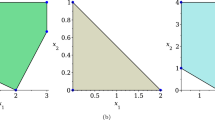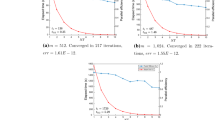Abstract
The Gröbner basis method for solving systems of polynomial equations became very popular in the computer vision community as it helps to find fast and numerically stable solutions to difficult problems. In this paper, we present a method that potentially significantly speeds up Gröbner basis solvers. We show that the elimination template matrices used in these solvers are usually quite sparse and that by permuting the rows and columns they can be transformed into matrices with nice block-diagonal structure known as the singly-bordered block-diagonal (SBBD) form. The diagonal blocks of the SBBD matrices constitute independent subproblems and can therefore be solved, i.e. eliminated or factored, independently. The computational time can be further reduced on a parallel computer by distributing these blocks to different processors for parallel computation. The speedup is visible also for serial processing since we perform \(O(n^3)\) Gauss-Jordan eliminations on smaller (usually two, approximately \({n \over 2} \times {n \over 2}\) and one \({n \over 3} \times {n \over 3}\)) matrices. We propose to compute the SBBD form of the elimination template in the preprocessing offline phase using hypergraph partitioning. The final online Gröbner basis solver works directly with the permuted block-diagonal matrices and can be efficiently parallelized. We demonstrate the usefulness of the presented method by speeding up solvers of several important minimal computer vision problems.
Access this chapter
Tax calculation will be finalised at checkout
Purchases are for personal use only
Similar content being viewed by others
References
Aykanat, C., Pinar, A., Catalyurek, U.V.: Permuting sparse rectangular matrices into block-diagonal form. SIAM J. Scientific Comput. 12/2002 (2002)
Bujnak, M., Kukelova, Z., Pajdla, T.: A general solution to the P4P problem for camera with unknown focal length. In: CVPR (2008)
Bujnak, M., Kukelova, Z., Pajdla, T.: New efficient solution to the absolute pose problem for camera with unknown focal length and radial distortion. In: Kimmel, R., Klette, R., Sugimoto, A. (eds.) ACCV 2010, Part I. LNCS, vol. 6492, pp. 11–24. Springer, Heidelberg (2011)
Bujnak, M., Kukelova, Z., Pajdla, T.: Making minimal solvers fast. In: CVPR (2008)
Byröd, M., Josephson, K., Åström, K.: Improving numerical accuracy of Gröbner basis polynomial equation solver. In: ICCV (2007)
Byröd, M., Josephson, K., Åström, K.: A column-pivoting based strategy for monomial ordering in numerical Gröbner basis calculations. In: Forsyth, D., Torr, P., Zisserman, A. (eds.) ECCV 2008, Part IV. LNCS, vol. 5305, pp. 130–143. Springer, Heidelberg (2008)
Byröd, M., Brown, M., Åström, K.: Minimal solutions for panoramic stitching with radial distortion. In: BMVC (2009)
Byröd, M.: Numerical methods for geometric vision: From minimal to large scale problems. Ph.D. Thesis, Centre for Mathematical Sciences, Lund University (2010)
Catalyurek, U.V., Aykanat, C.: PaToH: Partitioning Tool for Hypergraphs, Version 3.1 (2011)
Cox, D., Little, J., O’Shea, D.: Using Algebraic Geometry, vol. 185, 2nd edn. Springer, Berlin, Heidelberg, New York (2005)
Fiduccia, C.M., Mattheyses, R.M.: A linear-time heuristic for improving network partitions. In: 19th ACM/IEEE Design Automation Conference (1982)
Fischler, M.A., Bolles, R.C.: Random Sample Consensus: A paradigm for model fitting with applications to image analysis and automated cartography. Comm. ACM 24(6), 381–395 (1981)
Garey, M., Johnson, D., Stockmeyer, L.: Some simplified NP-complete graph problems. Theor. Comput. Sci. 1, 237–267 (1976)
Hook, D., McAree, P.: Using sturm sequences to bracket real roots of polynomial equations. In: Graphic Gems I, pp. 416–423. Academic Press (1990)
Josephson, K., Byröd, M.: Pose estimation with radial distortion and unknown focal length. In: CVPR 2009 (2009)
Kuehnle, K., Mayr, E.: Exponential space computation of Groebner bases. In: Proceedings of ISSAC. ACM (1996)
Kukelova, Z., Bujnak, M., Pajdla, T.: Automatic generator of minimal problem solvers. In: Forsyth, D., Torr, P., Zisserman, A. (eds.) ECCV 2008, Part III. LNCS, vol. 5304, pp. 302–315. Springer, Heidelberg (2008)
Kukelova, Z., Byröd, M., Josephson, K., Pajdla, T., Åström, K.: Fast and robust numerical solutions to minimal problems for cameras with radial distortion. Comput. Vis. Image Underst. 114(2), 234–244 (2010)
Kushal, A., Agarwal, S.: Visibility based preconditioning for bundle adjustment. In: CVPR 2012
Naroditsky, O., Daniilidis, K.: Optimizing polynomial solvers for minimal geometry problems. In: ICCV 2011
Nister, D.: An efficient solution to the five-point relative pose. IEEE PAMI 26(6), 756–770 (2004)
Stetter, H.J.: Numerical Polynomial Algebra. SIAM, Philadelphia (2004)
Stewenius, H., Nister, D., Kahl, F., Schaffalitzky, F.: A minimal solution for relative pose with unknown focal length. In: CVPR 2005
Stewenius, H., Engels, C., Nister, D.: Recent developments on direct relative orientation. ISPRS J. Photogrammetry Remote Sens. 60, 284–294 (2006)
Triggs, B., McLauchlan, P.F., Hartley, R.I., Fitzgibbon, A.W.: Bundle adjustment – A modern synthesis. In: Triggs, B., Zisserman, A., Szeliski, R. (eds.) ICCV-WS 1999. LNCS, vol. 1883, pp. 298–375. Springer, Heidelberg (2000)
Acknowledgement
This work has been supported by the EC under project PRoViDE FP7-SPACE-2012-312377.
Author information
Authors and Affiliations
Corresponding author
Editor information
Editors and Affiliations
Rights and permissions
Copyright information
© 2015 Springer International Publishing Switzerland
About this paper
Cite this paper
Kukelova, Z., Bujnak, M., Heller, J., Pajdla, T. (2015). Singly-Bordered Block-Diagonal Form for Minimal Problem Solvers. In: Cremers, D., Reid, I., Saito, H., Yang, MH. (eds) Computer Vision -- ACCV 2014. ACCV 2014. Lecture Notes in Computer Science(), vol 9004. Springer, Cham. https://doi.org/10.1007/978-3-319-16808-1_33
Download citation
DOI: https://doi.org/10.1007/978-3-319-16808-1_33
Published:
Publisher Name: Springer, Cham
Print ISBN: 978-3-319-16807-4
Online ISBN: 978-3-319-16808-1
eBook Packages: Computer ScienceComputer Science (R0)




